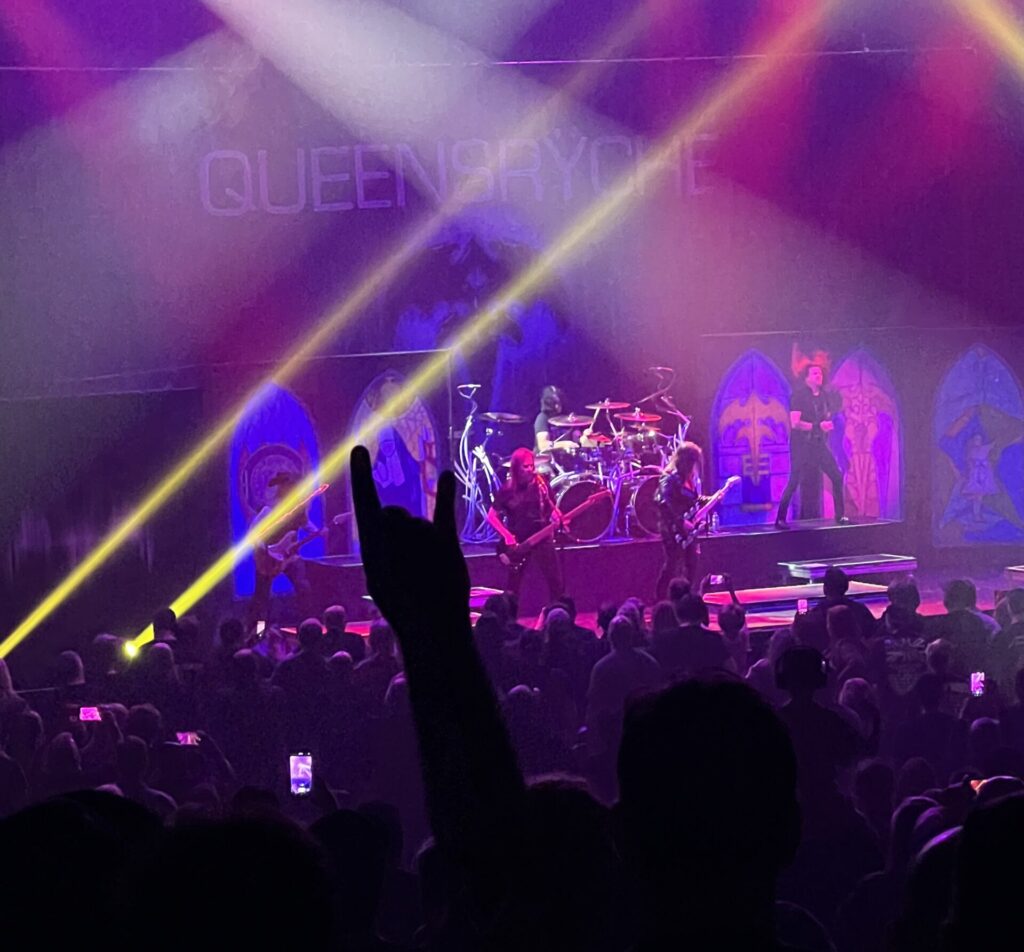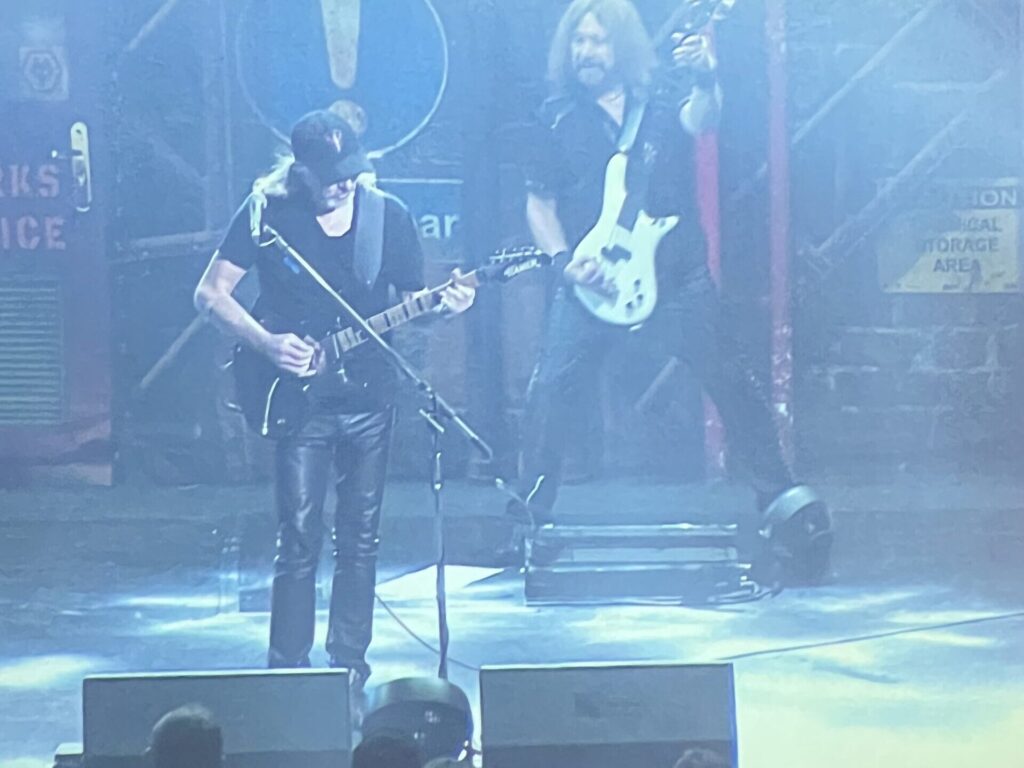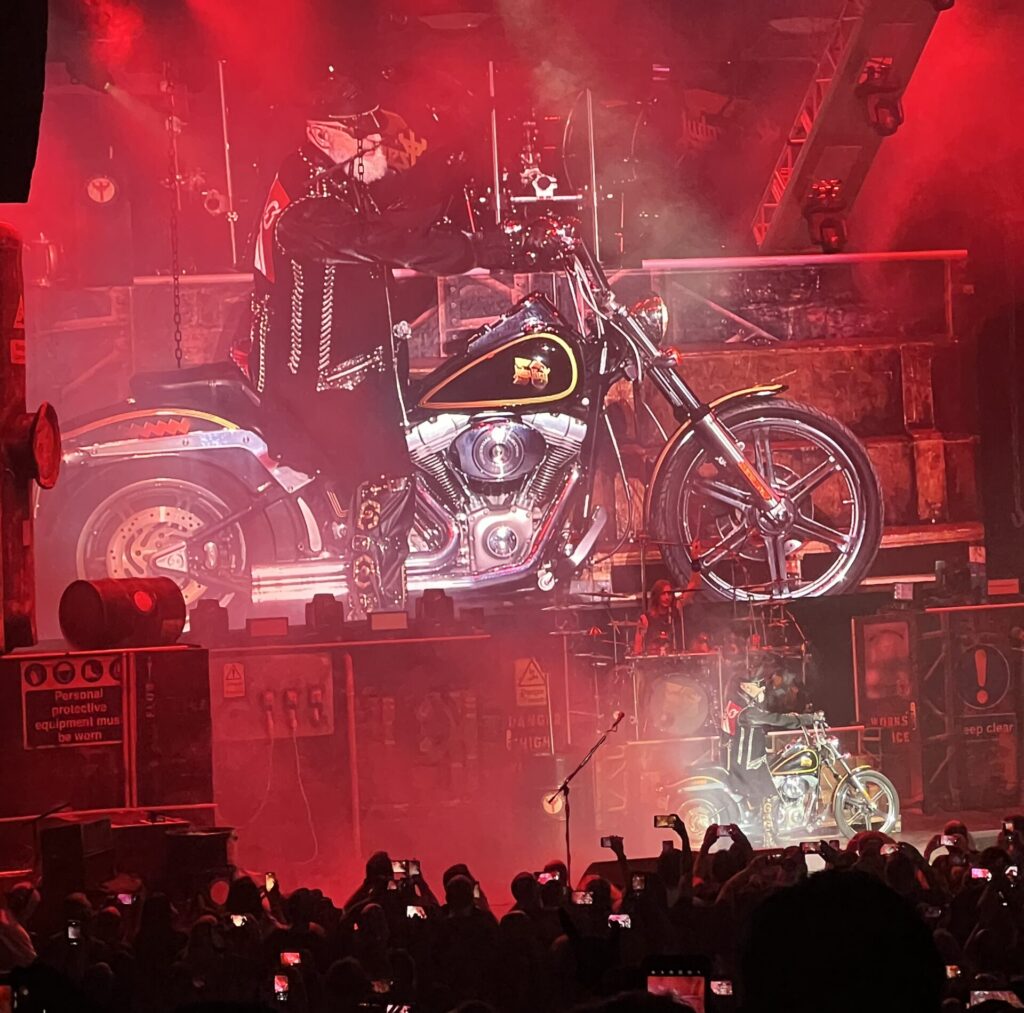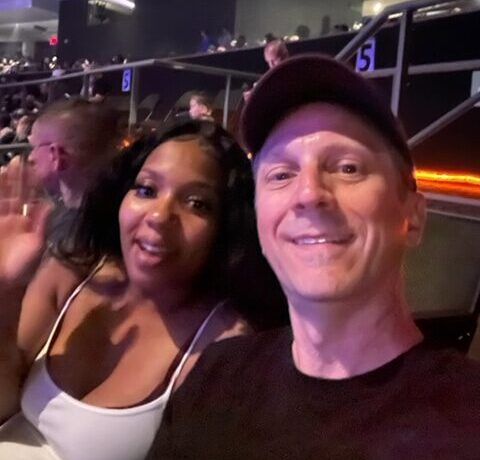I hadn’t been to a rock concert in years. (Has it been decades now?) They’ve gotten so damned expensive, and I’ve already seen most of the greats at least once. You know, last century. Now I have a younger girlfriend, Omri, who is discovering rock music for the first time. When she got hooked on some Judas Priest videos, and then discovered that they were on tour near us, I couldn’t resist. We attended the “50 Heavy Metal Years” tour in Phoenix, AZ on March 16. We loved it! It was one of my favorite concert events ever. But here’s my full critical take.
Queensryche was the opening act. This was another of my favorites back in the day, so I made sure that we got to the concert in time for this full set. Queensryche and Judas Priest now both squarely qualify as “Dinosaur Rock” bands. Their commercial success, popularity, and influence peaked long ago. But that’s what I like about concerts like this. Their casual fans — the ones who’d fill stadiums when the bands were trendy — stayed at home. We got to see these powerhouse acts in a theater (the kind where you’d go to see a play or musical) with a core of passionate lifelong fans. Omri was surrounded by middle-aged men. They were excited to see her, not just because she’s beautiful, but because she’s a young new recruit! They couldn’t stop regaling her with tales of their concert history and recommending bands to listen to.
For my sensibilities, the sound crew hasn’t adapted to the small-venue phase of these bands’ career. It was far louder than necessary for a space that size. I know, who ever complains about sound levels at a heavy metal concert?! But honestly, sometimes less is more. Stadium speakers weren’t meant for theater acoustics, so the sound was a bit mushy for my liking.
The fundamental question that Dinosaur Rock fans must ask ourselves is whether to accept changes in personnel. There are many purists who lose interest after one original member rotates out. While I have my favorite lineups, it’s getting late in the game for rock history. Changes are inevitable. I have come to appreciate the bands that persevere for decades no matter what they have to do to survive. If we can accept turnover in our favorite sports teams, why not bands?

That is a particularly salient question for Queensryche, which has been without signature-sound vocalist Geoff Tate for several years now. The two remaining original members are guitarist Michael Wilton and bassist Eddie Jackson. The band opted for a Tate sound-alike singer. There aren’t many of them in the world, and I have to admit that they plugged in a pretty damned good replacement in Todd La Torre. I was especially impressed when I read later that La Torre considers himself primarily a drummer, and only started singing as an afterthought. I sometimes feel that La Torre goes out of his way to mimic Tate down to every last inflection. He gets into that Uncanny Valley where he sounds so close to Tate that it bothers you that it isn’t Tate. I’ve seen an interview where he claims to have found his own distinct style. I don’t hear it, but again — he is definitely up to the challenge of the Queensryche repertoire.
I was surprised that Queensryche kept digging into its earliest albums. Although the band has albums as recent as 2019, every single song in this set came from 1983 – 1990. I was doubly surprised when Judas Priest did the same thing. The only song that postdated 1990 in this entire concert was Judas Priest’s “Lightning Strike” from 2018. Of course, the old material is what most fans came to hear, but bands usually like to try circulating and selling their newer material. That especially would have made sense with the “50 Heavy Metal Years” theme. Having heard a few 21st century Judas Priest songs, frankly, I think they would have been solid contributions to this set. Nevertheless, I have to agree, I am not very familiar with either band’s repertoire since 1990, so I was pleased to hear many old favorites. Queensryche, in particular, played so much of its old hardcore geek metal that it almost seemed like a deliberate attempt to weed out casual Empire fans!
A few other choices surprised me. Judas Priest played some tracks from my favorite under-rated albums, such as “Desert Plains” (Point of Entry, 1981) and even “Blood Red Skies” (Ram It Down, 1988). I don’t think I’d ever heard Judas Priest play a song from Ram It Down live; for years they seemed to go into denial that they’d ever made this album, the long-lost sleeper between Screaming for Vengeance and Painkiller. Judging from reactions around me, Blood Red Skies was actually a fan favorite for the evening (Omri agreed!)
I created a YouTube playlist of both bands’ full set lists for this evening’s show. These are official videos, many of them quite old, not recordings from the concert.
And now I must come to my most controversial assessment. Rob Halford’s voice is aging. I heard him in concert at least three times in the ’90s and ’00s. Each time, I was blown away by the strength, elasticity, and purity of his voice. I give him kudos to what he is still doing now, but I could tell that he is simply not capable of keeping up with his younger self. As a former heavy metal vocalist wannabe myself, I know the pains of navigating the break between chest voice and head voice. Most mere mortals like me have a gap there spanning about a third, where both vocal modes are weak and crossing that point is vocally exhausting. Halford used to breeze through that part of the range like a canary. Now he falls into a mute spot there. His upper range is no longer clear. Apparently, the only way he can reach his highest notes now is with Bryan Johnson-esque fry vocals. I don’t see or hear many people discussing this. Maybe it’s just me, or maybe people don’t want to say anything because we all love Halford.
For me it was kind of emotional, though. I have a 30-year history with Judas Priest concerts. Now I feel that an era has passed. The Rob Halford that I knew just isn’t there anymore. Juxtaposed with the Queensryche performance, it made me ponder an unthinkable question. Would I prefer to see Judas Priest with Ripper Owens? I’d choose 20th century Halford over Owens any time. (That’s what recordings are for). But honestly, I think that Owens (who is two decades younger) is stronger than Halford today.
Speaking of the old-timers, it was great to see two other original band members there. Bassist Ian Hill has been in Judas Priest slightly longer than Rob Halford. The original dual guitar lineup of K.K. Downing and Glenn Tipton has now been replaced by younger blood. Downing’s replacement, Richie Faulkner, is phenomenal. He electrified the stage from start to finish. Tipton’s touring stand-in, Andy Sneap, didn’t make as much of an impression on me. He is better known as a producer, and he is not well embedded with this band yet. Tipton, who has Parkinson’s Disease, still plays in the studio. In fact, he still does a little touring too. He hides out backstage through most of the set, but then Rob Halford calls Tipton on stage to join the band for a couple of encore songs. Tipton coming in for “Metal Gods” got one of the biggest cheers of the night.

I am also happy to see that Travis Scott has been with the band this long. One of the interesting quirks about Judas Priest is that, through its entire heyday, it didn’t have a steady drummer. Travis Scott is “the new guy” who came on board for the Painkiller album. Now he introduces the song Painkiller every night of this tour, three decades later.

